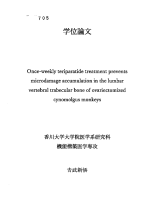Once-weekly teriparatide treatment prevents microdamage accumulation in the lumbar vertebral trabecular bone of ovariectomized cynomolgus monkeys
Access this Article
Author
Bibliographic Information
- Title
-
Once-weekly teriparatide treatment prevents microdamage accumulation in the lumbar vertebral trabecular bone of ovariectomized cynomolgus monkeys
- Author
-
吉武, 新悟
- University
-
香川大学
- Types of degree
-
博士(医学)
- Grant ID
-
甲第705号
- Degree year
-
2019-03-24
Note and Description
AbstractThe effect of teriparatide treatment on microdamage accumulation has yet to be examined in animal studies. The purpose of this study was to investigate the effect of once-weekly teriparatide treatment on bone microdamage accumulation and the relationship between microdamage parameters and bone mass, architecture, turnover, and collagen cross-linking in the lumbar vertebral trabecular bone of ovariectomized (OVX) cynomolgus monkeys. Female monkeys were divided into four groups (n = 18–20 per group): (1) SHAM group, (2) OVX group, (3) OVX with 1.2 µg/kg once-weekly teriparatide group (LOW group), (4) OVX with 6.0 µg/kg once-weekly teriparatide group (HIGH group). After 18 months, all animals were double-labeled with calcein for histomorphometry. L3 and L7 lumbar vertebrae were harvested and analyzed for differences in histomorphometry, microdamage, and collagen cross-linking. The iliac crest was also analyzed for differences in bone turnover. In the OVX group, cancellous bone mass was reduced and microdamage accumulation was increased as compared with the SHAM control. Once-weekly teriparatide at both doses prevented the decrease in bone mass and increase in microdamage accumulation, and improved the distribution of collagen cross-linkage types. Regression analyses indicated that decreased microdamage accumulation was associated with reduced non-enzymatic cross-link pentosidine rather than increased cancellous bone mass or enzymatic cross-links. These findings suggest that once-weekly teriparatide treatment decreases microdamage accumulation by recovering the balance in collagen cross-links.
Abstract The effect of teriparatide treatment on microdamage accumulation has yet to be examined in animal studies. The purpose of this study was to investigate the effect of once-weekly teriparatide treatment on bone microdamage accumulation and the relationship between microdamage parameters and bone mass, architecture, turnover, and collagen cross-linking in the lumbar vertebral trabecular bone of ovariectomized (OVX) cynomolgus monkeys. Female monkeys were divided into four groups (n = 18–20 per group): (1) SHAM group, (2) OVX group, (3) OVX with 1.2 µg/kg once-weekly teriparatide group (LOW group), (4) OVX with 6.0 µg/kg once-weekly teriparatide group (HIGH group). After 18 months, all animals were double-labeled with calcein for histomorphometry. L3 and L7 lumbar vertebrae were harvested and analyzed for differences in histomorphometry, microdamage, and collagen cross-linking. The iliac crest was also analyzed for differences in bone turnover. In the OVX group, cancellous bone mass was reduced and microdamage accumulation was increased as compared with the SHAM control. Once-weekly teriparatide at both doses prevented the decrease in bone mass and increase in microdamage accumulation, and improved the distribution of collagen cross-linkage types. Regression analyses indicated that decreased microdamage accumulation was associated with reduced non-enzymatic cross-link pentosidine rather than increased cancellous bone mass or enzymatic cross-links. These findings suggest that once-weekly teriparatide treatment decreases microdamage accumulation by recovering the balance in collagen cross-links.


